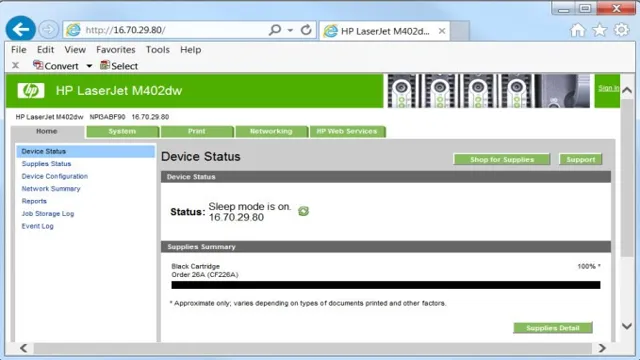If you own an HP printer, you may not realize that it likely has an Embedded Web Server (EWS) that allows you to access and control the printer’s settings using a web browser. This may sound fancy, but it’s really just a way for you to manage your printer from your computer or mobile device without having to physically interact with the device itself. Essentially, the EWS turns your printer into a little web server, allowing you to access and manage its settings through a familiar web interface.
So, why would you want to use the EWS, and what can you do with it? Let’s take a closer look.
What is an Embedded Web Server?
An embedded web server is a small computer that is integrated into a larger system and allows it to connect to the internet. For example, an HP printer with an embedded web server can be accessed and controlled over the internet via a web browser, allowing users to check ink levels, run maintenance tasks, and even print documents from remote locations. The embedded web server provides a user-friendly interface that allows for easy online administration and control of the device.
This technology is becoming increasingly common in modern appliances and equipment, as it allows for greater flexibility and convenience for both users and manufacturers. With an embedded web server, devices can be easily monitored and managed remotely, without requiring physical access to the equipment. This makes it easier to troubleshoot problems, reduce downtime, and improve overall efficiency.
So, if you’re looking for a smart and convenient way to control your printers, an HP printer with an embedded web server may be just what you need.
Explanation of Embedded Web Servers
An embedded web server is a type of web server that is designed specifically to operate on small, resource-constrained devices, such as printers, medical equipment, and home automation systems, without the need for external hardware or software. It is essentially a small web server that is integrated into the device’s firmware, enabling it to host a web-based user interface that can be accessed from any web browser. Embedded web servers typically operate on a small, low-power processor, with minimal memory and storage capacity, which means that they need to be very efficient in their use of resources.
Despite this, they are capable of performing basic web server tasks, such as serving static web pages and processing simple HTTP requests. The advantage of an embedded web server is that it provides a simple, easy-to-use interface for controlling and monitoring the device from any location, without the need for specialized software or hardware. It also allows manufacturers to add new features and functionality to their devices without requiring a hardware or software update, simply by updating the web server firmware.
Overall, an embedded web server is an essential component of many modern devices, providing a flexible, cost-effective way to control and monitor them from anywhere in the world.

Benefits of an Embedded Web Server for HP Printers
An embedded web server in an HP printer can provide multiple benefits for users. First and foremost, it allows for remote access and management of the printer through a web browser, providing convenience and ease of use. This feature also enables users to monitor printer status, troubleshoot issues, and perform maintenance tasks virtually, minimizing the need for on-site support.
Additionally, an embedded web server can provide advanced security features, such as user authentication and access control, to protect confidential or sensitive data. The web server can also facilitate firmware updates and deployment of new features, ensuring that the printer stays up-to-date and continues to provide optimal performance. With the use of an embedded web server, HP printers can deliver enhanced functionality and improve overall productivity.
Increased Productivity and Efficiency
An embedded web server is an incredibly useful feature in HP printers. It allows for increased productivity and efficiency in a variety of ways. With an embedded web server, users can access various printer settings and functions remotely from any device with an internet connection.
This means they can print, scan, and manage print jobs without physically being at the printer. Additionally, an embedded web server allows for easy printer maintenance and updates, saving both time and money. Another benefit is the ability to manage user access and monitor usage, improving security and reducing printing costs.
Overall, an embedded web server is a valuable tool that businesses and individuals should consider when choosing a printer.
Ease of Management and Maintenance
An embedded web server for HP printers can definitely make management and maintenance a lot easier. With this feature, you can access your printer’s settings and perform tasks remotely, which saves you time and effort. You don’t have to physically go to your printer to change settings or fix issues as everything can be done through a web browser on your computer or mobile device.
This is especially helpful if you have multiple printers in different locations. Additionally, an embedded web server can provide you with real-time data about your printer’s performance and usage, which can help you optimize its performance and prevent unexpected breakdowns. It’s like having a personal assistant that takes care of your printer’s needs, leaving you more time to focus on other important tasks.
So if you want to save time and streamline your printing experience, getting a printer with an embedded web server is definitely worth considering.
How to Access and Use the Embedded Web Server on Your HP Printer
If you own an HP printer, it may interest you to know that you can access and use the embedded web server (EWS) on your printer. The HP EWS is a built-in feature that enables users to configure printer settings, manage print jobs, and access printer information using a web browser. The EWS is accessible through the printer’s IP address, which you can find by printing a network configuration page.
Once you have the IP address, simply enter it into your web browser’s address bar to access the EWS dashboard. From there, you can configure various printer settings such as print quality, network settings, and security options. You can also use the EWS to view printer status information such as ink levels, paper jams, and error messages.
With the EWS, managing and monitoring your HP printer has never been easier.
Step-by-Step Guide
HP Printer Embedded Web Server The HP Printer Embedded Web Server is a useful tool that allows you to manage and configure your printer from your computer. Setting up the Embedded Web Server is easy and straightforward. The first step is to make sure that the printer is connected to your network.
Once the printer is connected, you can access the Embedded Web Server by entering the printer’s IP address into your web browser. From there, you can manage various settings, such as configuring the network connection, managing print jobs, and updating the firmware. The Embedded Web Server is a powerful tool that can help you get the most out of your HP Printer.
So, if you haven’t already done so, give it a try and see what it can do for you!
Features and Functions Available Through the Embedded Web Server
If you’re the owner of an HP Printer, accessing and using the Embedded Web Server might be something you’re interested in. The Embedded Web Server provides advanced features and functions that can help streamline your printing process. To access it, you simply need to open up a web browser on your computer, type in your printer’s IP address, and press enter.
From there, you’ll be able to perform a wide range of tasks, such as checking your printer’s ink levels, setting up wireless printing, and managing print jobs. You can even customize your printer’s settings to suit your specific needs. So, if you’re looking for a way to make your printing process more efficient, be sure to take advantage of all the Embedded Web Server has to offer.
Security Measures for an Embedded Web Server HP Printer
When it comes to utilizing an embedded web server on an HP printer, security should top your list of priorities. After all, an unprotected server can open up your device to cyber attacks, putting both your printer and your network at risk. One of the most important security measures is to regularly update your printer’s firmware, which can address newly discovered vulnerabilities and patch any pre-existing ones.
Additionally, using a strong, unique password for your printer’s web interface and ensuring it is not easily guessable is crucial. Encryption is another key consideration, as it protects data transmitted between the printer and web server by scrambling it into unintelligible code. As an extra security measure, it’s recommended to use a firewall and restrict access to the printer’s web server to authorized users only.
Finally, maintaining the physical security of the printer, such as locking it in a secure area or monitoring its surroundings, can also help prevent unauthorized access to the server. When it comes to an embedded web server HP printer, taking these steps can go a long way in safeguarding your device and network.
Best Practices for Secure Access and Usage
When it comes to accessing and using an embedded web server on an HP Printer, there are some critical security measures that you should take to ensure your data and devices are safe. These measures include changing the default login credentials on your printer, creating strong passwords, and enabling two-factor authentication. It is also important to keep your printer’s firmware and software up-to-date to mitigate any vulnerabilities or security gaps.
Furthermore, restricting access to the embedded web server to authorized personnel only through the use of firewalls and network segmentation can also help to enhance security. By implementing these best practices for secure access and usage, you can be confident that your HP Printer is safeguarded against cyber threats and unauthorized access, allowing you to focus on your work without any security concerns.
Conclusion
In conclusion, an embedded web server in an HP printer is like having a miniaturized IT department right at your fingertips. With a few clicks of your mouse, you can access and manage your printer’s settings, troubleshoot issues, and even order new supplies. It’s like having a personal assistant that not only keeps your printer running smoothly but also makes your life easier.
So, the next time you print out a document, take a moment to appreciate the impressive technology behind that trusty little device sitting on your desk. Who knew a printer could be so clever and witty?”
FAQs
What is an embedded web server in an HP printer?
An embedded web server is a web-based interface on an HP printer that allows users to access the printer’s configuration settings and monitor its status using a web browser on a computer.
How do I access the embedded web server on my HP printer?
To access the embedded web server on your HP printer, open a web browser on your computer and enter the IP address of the printer into the address bar. You can find the printer’s IP address by printing a configuration page from the printer’s control panel.
What can I do with the embedded web server on my HP printer?
Using the embedded web server on your HP printer, you can manage print jobs, configure network settings, check ink or toner levels, and troubleshoot common issues.
Can I password protect the embedded web server on my HP printer?
Yes, you can set up a username and password to secure the embedded web server on your HP printer. This will prevent unauthorized users from accessing the printer’s settings and status information.


